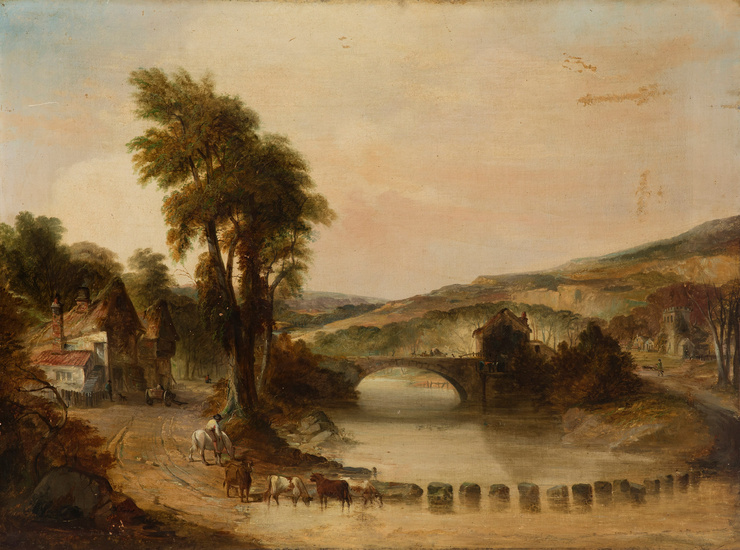Dutch school from the end of the 18th century-early 19th century
Dutch school from the end of the 18th century-early 19th century.
"Landscape.
Oil on canvas.
Re-drawn in the 19th century. Frame from the 19th century.
Presents old restorations and lack of polychromy.
Signed "W. KOEKKOEK, 61".
Measurements: 84 x 112 cm, 113 x 144 cm (frame).
It was undoubtedly in the paintings of the Dutch school that the consequences of the political emancipation of the region and the economic prosperity of the liberal bourgeoisie were most openly manifested. The combination of the discovery of nature, objective observation, the study of the concrete, the appreciation of the everyday, the taste for the real and the material, the sensitivity to the apparently insignificant, meant that the Dutch artist was at one with the reality of everyday life, without seeking any ideal that was alien to that same reality. The painter did not seek to transcend the present and the materiality of objective nature or to escape from tangible reality, but to envelop himself in it, to become intoxicated by it through the triumph of realism, a realism of pure illusory fiction, achieved thanks to a perfect, masterly technique and a conceptual subtlety in the lyrical treatment of light.
He was a member of the famous Koekkoek family of painters; son of the marine artist, Hermanus Koekkoek, and grandson of Johannes Hermanus Koekkoek. His brothers, Hermanus, Johannes Hermanus Barend and Hendrik Barend became painters.
Following the family tradition, his father gave all four brothers their first art lessons. Willem was also trained as an architect, but only practised that profession for a short time. However, he left a lasting influence on his choice of subject matter.
From 1854 to 1878, he worked in The Hague and then in Amsterdam. His first exhibition was in 1859 in Leeuwarden. [1] From 1865 to 1894, he held annual exhibitions at the Royal Academy of Art and the Rijksakademie in Amsterdam. He had several exhibitions in private galleries in London from 1885 to 1888. His brother, Hermanus, moved to London and opened an art dealership in 1869, which made his works and those of the whole family popular in England.
In November 1866 he married Johanna Hermina. They had two sons who became artists, Marinus Adrianus, known as "The Younger", who became an illustrator, and Hermanus Willwm, who specialised in military subjects. Again, following tradition, Willem provided his first lessons.
Sometime in the 1880s, he moved to Amstelveen. By then, his brother, Hendrik Barend, had moved to London and his son, Hermanus, eventually did too. Although Willem painted almost entirely for his English clientele, he remained in the Netherlands. He stopped exhibiting, and painted little, from 1894 onwards owing to ill health, and died the following year, shortly after his fifty-sixth birthday.
COMMENTS
Reentelado en el siglo XIX. Marco del siglo XIX. Presenta restauraciones antiguas y falta de policromía.
This lot can be seen at the Setdart Valencia Gallery located at C/Cirilo Amorós, 55.
View it on
Estimate
Time, Location
Auction House
Dutch school from the end of the 18th century-early 19th century.
"Landscape.
Oil on canvas.
Re-drawn in the 19th century. Frame from the 19th century.
Presents old restorations and lack of polychromy.
Signed "W. KOEKKOEK, 61".
Measurements: 84 x 112 cm, 113 x 144 cm (frame).
It was undoubtedly in the paintings of the Dutch school that the consequences of the political emancipation of the region and the economic prosperity of the liberal bourgeoisie were most openly manifested. The combination of the discovery of nature, objective observation, the study of the concrete, the appreciation of the everyday, the taste for the real and the material, the sensitivity to the apparently insignificant, meant that the Dutch artist was at one with the reality of everyday life, without seeking any ideal that was alien to that same reality. The painter did not seek to transcend the present and the materiality of objective nature or to escape from tangible reality, but to envelop himself in it, to become intoxicated by it through the triumph of realism, a realism of pure illusory fiction, achieved thanks to a perfect, masterly technique and a conceptual subtlety in the lyrical treatment of light.
He was a member of the famous Koekkoek family of painters; son of the marine artist, Hermanus Koekkoek, and grandson of Johannes Hermanus Koekkoek. His brothers, Hermanus, Johannes Hermanus Barend and Hendrik Barend became painters.
Following the family tradition, his father gave all four brothers their first art lessons. Willem was also trained as an architect, but only practised that profession for a short time. However, he left a lasting influence on his choice of subject matter.
From 1854 to 1878, he worked in The Hague and then in Amsterdam. His first exhibition was in 1859 in Leeuwarden. [1] From 1865 to 1894, he held annual exhibitions at the Royal Academy of Art and the Rijksakademie in Amsterdam. He had several exhibitions in private galleries in London from 1885 to 1888. His brother, Hermanus, moved to London and opened an art dealership in 1869, which made his works and those of the whole family popular in England.
In November 1866 he married Johanna Hermina. They had two sons who became artists, Marinus Adrianus, known as "The Younger", who became an illustrator, and Hermanus Willwm, who specialised in military subjects. Again, following tradition, Willem provided his first lessons.
Sometime in the 1880s, he moved to Amstelveen. By then, his brother, Hendrik Barend, had moved to London and his son, Hermanus, eventually did too. Although Willem painted almost entirely for his English clientele, he remained in the Netherlands. He stopped exhibiting, and painted little, from 1894 onwards owing to ill health, and died the following year, shortly after his fifty-sixth birthday.
COMMENTS
Reentelado en el siglo XIX. Marco del siglo XIX. Presenta restauraciones antiguas y falta de policromía.
This lot can be seen at the Setdart Valencia Gallery located at C/Cirilo Amorós, 55.



